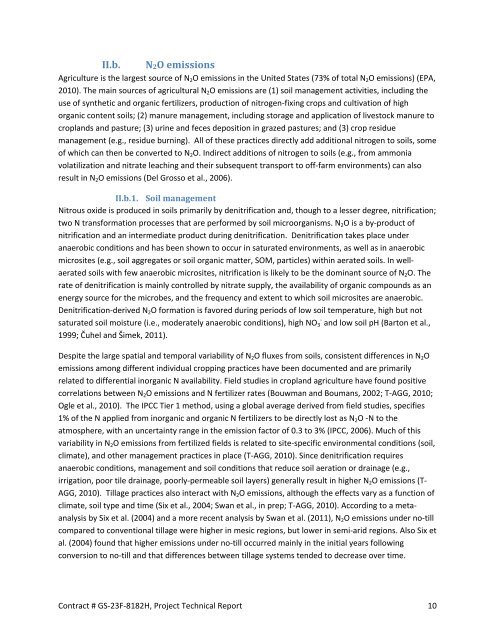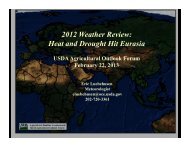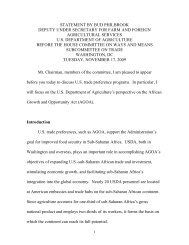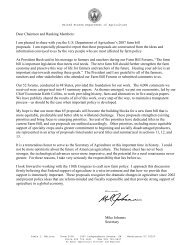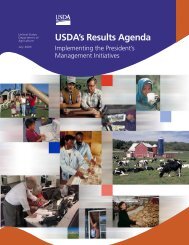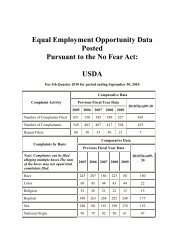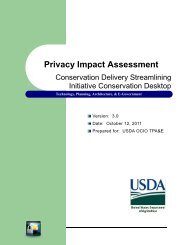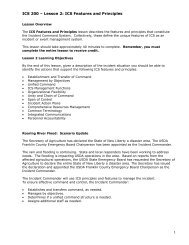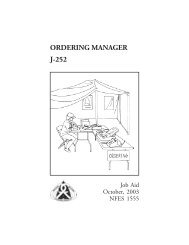Greenhouse Gas Emissions from U.S. Agriculture and Forestry: A ...
Greenhouse Gas Emissions from U.S. Agriculture and Forestry: A ...
Greenhouse Gas Emissions from U.S. Agriculture and Forestry: A ...
Create successful ePaper yourself
Turn your PDF publications into a flip-book with our unique Google optimized e-Paper software.
II.b. N2O emissions<br />
<strong>Agriculture</strong> is the largest source of N2O emissions in the United States (73% of total N2O emissions) (EPA,<br />
2010). The main sources of agricultural N2O emissions are (1) soil management activities, including the<br />
use of synthetic <strong>and</strong> organic fertilizers, production of nitrogen‐fixing crops <strong>and</strong> cultivation of high<br />
organic content soils; (2) manure management, including storage <strong>and</strong> application of livestock manure to<br />
cropl<strong>and</strong>s <strong>and</strong> pasture; (3) urine <strong>and</strong> feces deposition in grazed pastures; <strong>and</strong> (3) crop residue<br />
management (e.g., residue burning). All of these practices directly add additional nitrogen to soils, some<br />
of which can then be converted to N2O. Indirect additions of nitrogen to soils (e.g., <strong>from</strong> ammonia<br />
volatilization <strong>and</strong> nitrate leaching <strong>and</strong> their subsequent transport to off‐farm environments) can also<br />
result in N2O emissions (Del Grosso et al., 2006).<br />
II.b.1. Soil management<br />
Nitrous oxide is produced in soils primarily by denitrification <strong>and</strong>, though to a lesser degree, nitrification;<br />
two N transformation processes that are performed by soil microorganisms. N2O is a by‐product of<br />
nitrification <strong>and</strong> an intermediate product during denitrification. Denitrification takes place under<br />
anaerobic conditions <strong>and</strong> has been shown to occur in saturated environments, as well as in anaerobic<br />
microsites (e.g., soil aggregates or soil organic matter, SOM, particles) within aerated soils. In well‐<br />
aerated soils with few anaerobic microsites, nitrification is likely to be the dominant source of N2O. The<br />
rate of denitrification is mainly controlled by nitrate supply, the availability of organic compounds as an<br />
energy source for the microbes, <strong>and</strong> the frequency <strong>and</strong> extent to which soil microsites are anaerobic.<br />
Denitrification‐derived N2O formation is favored during periods of low soil temperature, high but not<br />
saturated soil moisture (i.e., moderately anaerobic conditions), high NO3 ‐ <strong>and</strong> low soil pH (Barton et al.,<br />
1999; Čuhel <strong>and</strong> Šimek, 2011).<br />
Despite the large spatial <strong>and</strong> temporal variability of N2O fluxes <strong>from</strong> soils, consistent differences in N2O<br />
emissions among different individual cropping practices have been documented <strong>and</strong> are primarily<br />
related to differential inorganic N availability. Field studies in cropl<strong>and</strong> agriculture have found positive<br />
correlations between N2O emissions <strong>and</strong> N fertilizer rates (Bouwman <strong>and</strong> Boumans, 2002; T‐AGG, 2010;<br />
Ogle et al., 2010). The IPCC Tier 1 method, using a global average derived <strong>from</strong> field studies, specifies<br />
1% of the N applied <strong>from</strong> inorganic <strong>and</strong> organic N fertilizers to be directly lost as N2O ‐N to the<br />
atmosphere, with an uncertainty range in the emission factor of 0.3 to 3% (IPCC, 2006). Much of this<br />
variability in N2O emissions <strong>from</strong> fertilized fields is related to site‐specific environmental conditions (soil,<br />
climate), <strong>and</strong> other management practices in place (T‐AGG, 2010). Since denitrification requires<br />
anaerobic conditions, management <strong>and</strong> soil conditions that reduce soil aeration or drainage (e.g.,<br />
irrigation, poor tile drainage, poorly‐permeable soil layers) generally result in higher N2O emissions (T‐<br />
AGG, 2010). Tillage practices also interact with N2O emissions, although the effects vary as a function of<br />
climate, soil type <strong>and</strong> time (Six et al., 2004; Swan et al., in prep; T‐AGG, 2010). According to a meta‐<br />
analysis by Six et al. (2004) <strong>and</strong> a more recent analysis by Swan et al. (2011), N2O emissions under no‐till<br />
compared to conventional tillage were higher in mesic regions, but lower in semi‐arid regions. Also Six et<br />
al. (2004) found that higher emissions under no‐till occurred mainly in the initial years following<br />
conversion to no‐till <strong>and</strong> that differences between tillage systems tended to decrease over time.<br />
Contract # GS‐23F‐8182H, Project Technical Report 10


